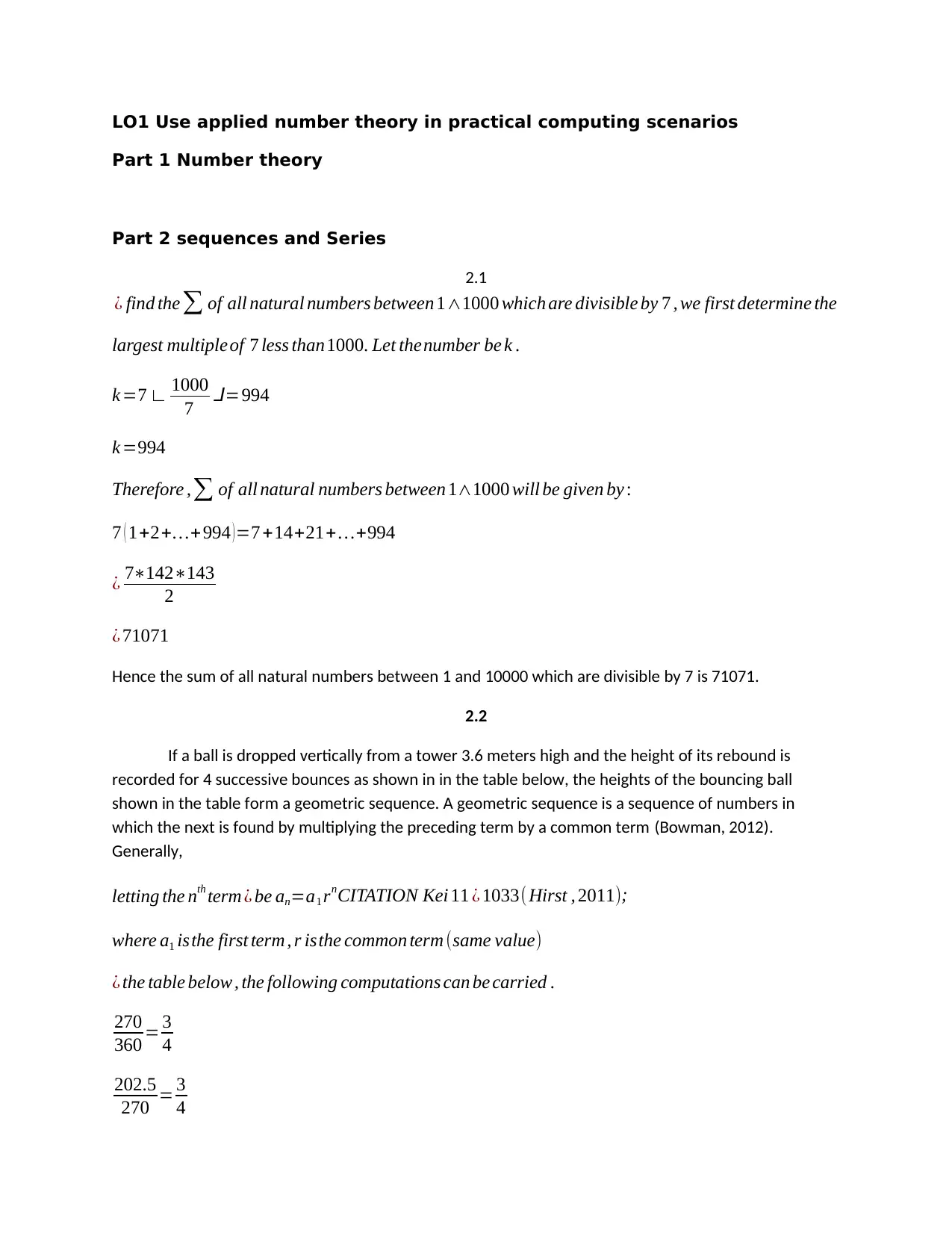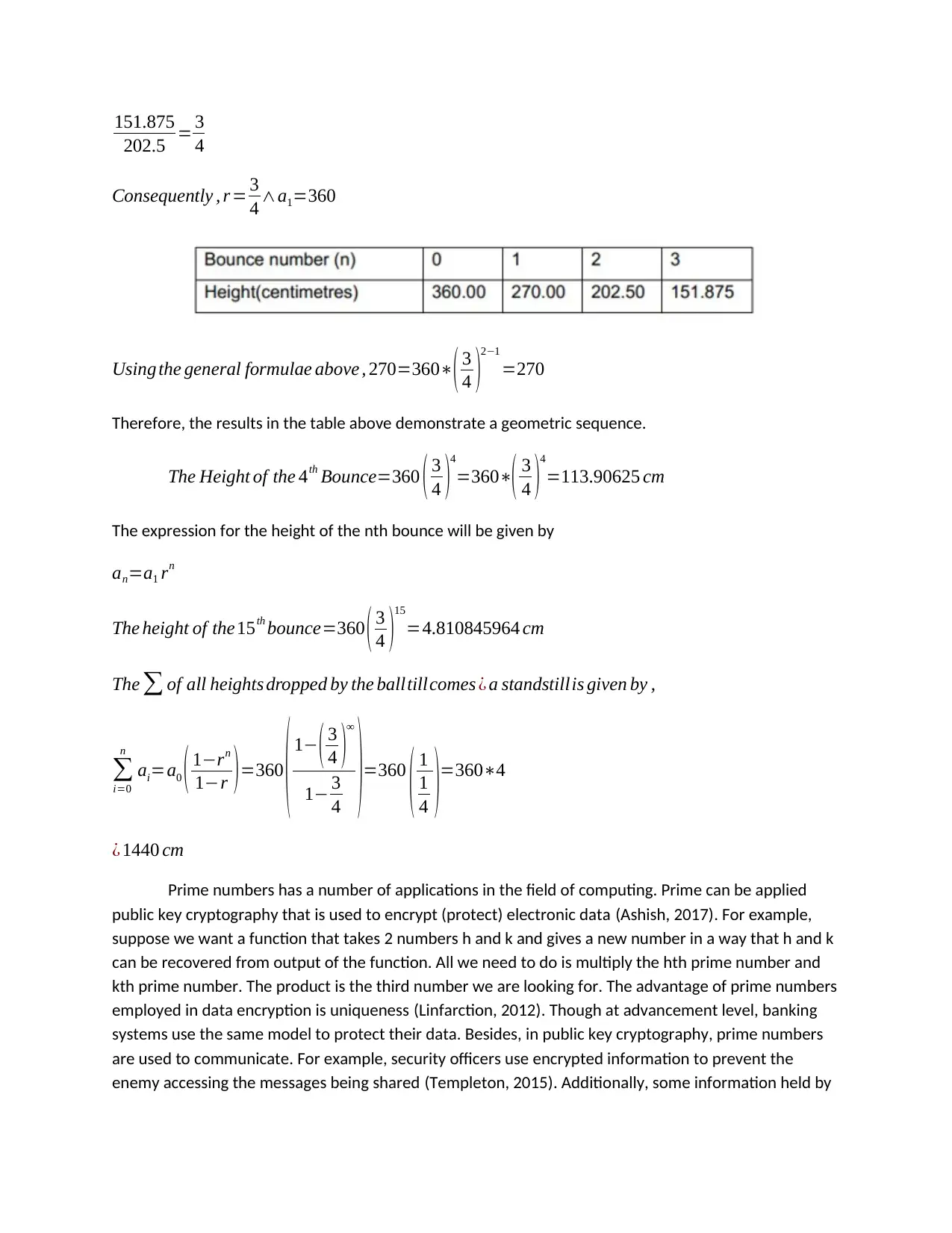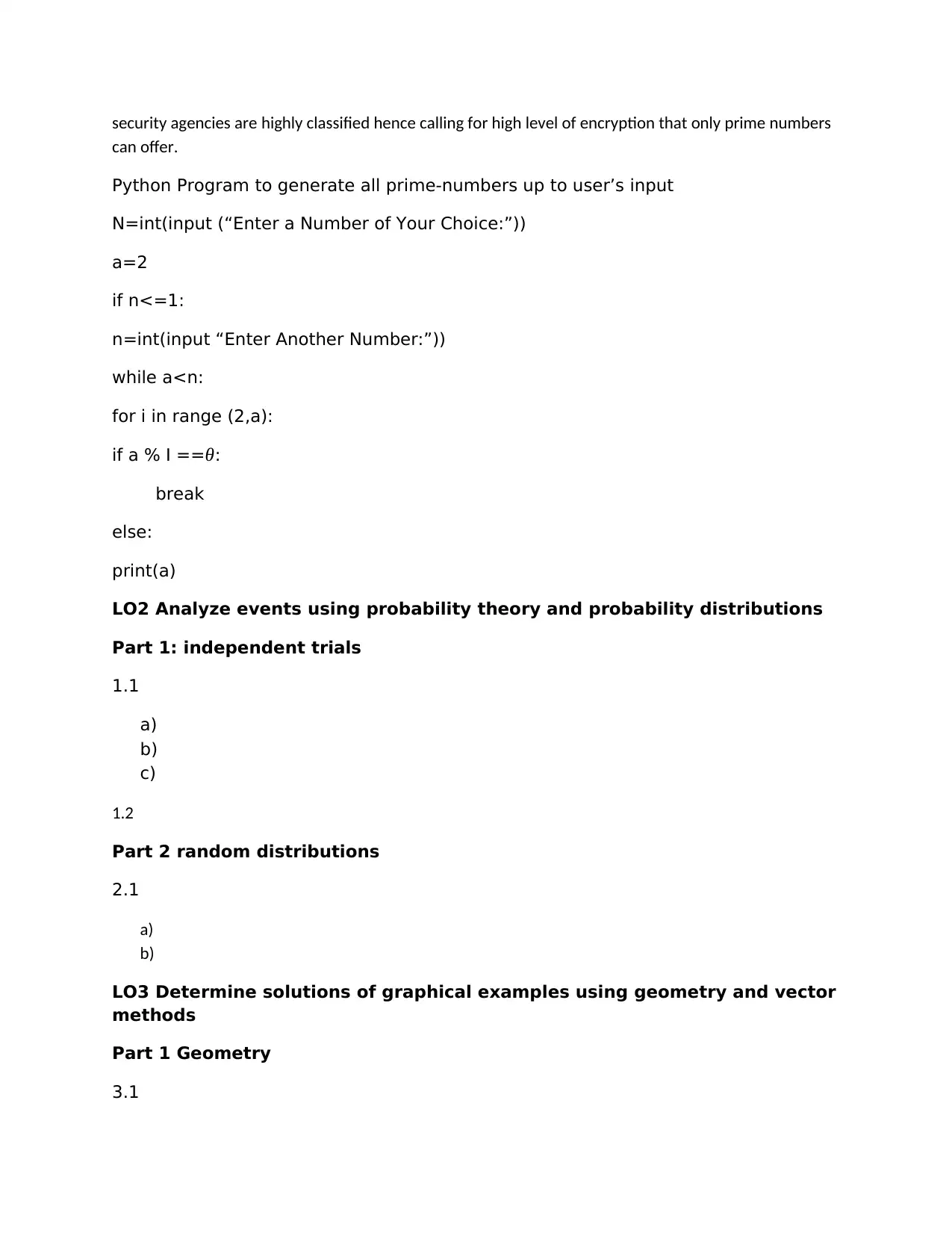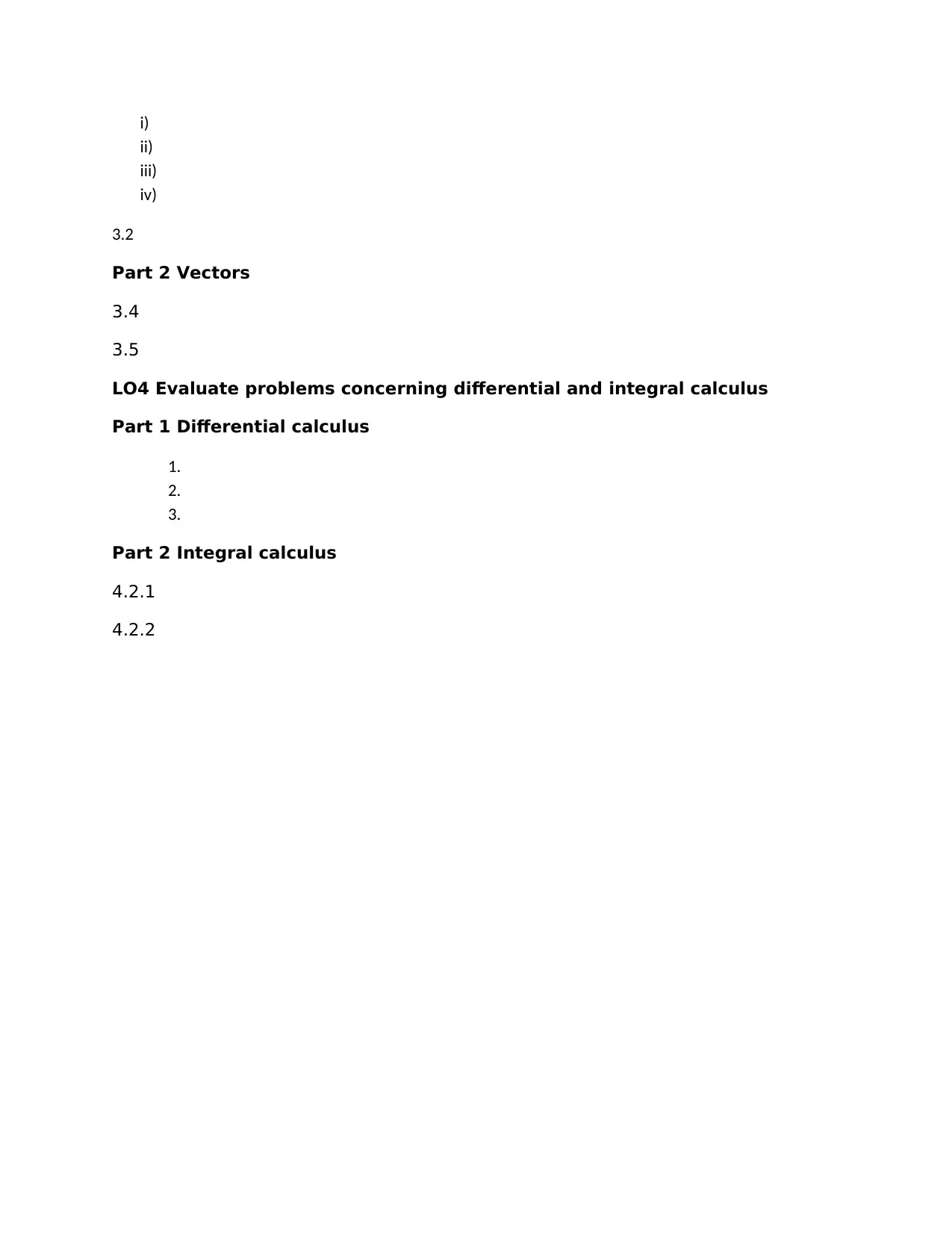Theory in practical computing scenarios PDF
VerifiedAdded on 2021/10/28
|4
|469
|229
AI Summary
Contribute Materials
Your contribution can guide someone’s learning journey. Share your
documents today.

LO1 Use applied number theory in practical computing scenarios
Part 1 Number theory
Part 2 sequences and Series
2.1
¿ find the∑ of all natural numbers between 1∧1000 which are divisible by 7 , we first determine the
largest multiple of 7 less than1000. Let thenumber be k .
k =7 ∟ 1000
7 ⅃=994
k =994
Therefore ,∑ of all natural numbers between 1∧1000 will be given by :
7 ( 1+2+…+ 994 )=7 +14+21+…+994
¿ 7∗142∗143
2
¿ 71071
Hence the sum of all natural numbers between 1 and 10000 which are divisible by 7 is 71071.
2.2
If a ball is dropped vertically from a tower 3.6 meters high and the height of its rebound is
recorded for 4 successive bounces as shown in in the table below, the heights of the bouncing ball
shown in the table form a geometric sequence. A geometric sequence is a sequence of numbers in
which the next is found by multiplying the preceding term by a common term (Bowman, 2012).
Generally,
letting the nth term ¿ be an=a1 rnCITATION Kei 11 ¿ 1033( Hirst , 2011) ;
where a1 isthe first term , r isthe common term (same value)
¿ the table below , the following computations can be carried .
270
360 = 3
4
202.5
270 = 3
4
Part 1 Number theory
Part 2 sequences and Series
2.1
¿ find the∑ of all natural numbers between 1∧1000 which are divisible by 7 , we first determine the
largest multiple of 7 less than1000. Let thenumber be k .
k =7 ∟ 1000
7 ⅃=994
k =994
Therefore ,∑ of all natural numbers between 1∧1000 will be given by :
7 ( 1+2+…+ 994 )=7 +14+21+…+994
¿ 7∗142∗143
2
¿ 71071
Hence the sum of all natural numbers between 1 and 10000 which are divisible by 7 is 71071.
2.2
If a ball is dropped vertically from a tower 3.6 meters high and the height of its rebound is
recorded for 4 successive bounces as shown in in the table below, the heights of the bouncing ball
shown in the table form a geometric sequence. A geometric sequence is a sequence of numbers in
which the next is found by multiplying the preceding term by a common term (Bowman, 2012).
Generally,
letting the nth term ¿ be an=a1 rnCITATION Kei 11 ¿ 1033( Hirst , 2011) ;
where a1 isthe first term , r isthe common term (same value)
¿ the table below , the following computations can be carried .
270
360 = 3
4
202.5
270 = 3
4
Secure Best Marks with AI Grader
Need help grading? Try our AI Grader for instant feedback on your assignments.

151.875
202.5 = 3
4
Consequently , r = 3
4 ∧a1=360
Using the general formulae above , 270=360∗( 3
4 )
2−1
=270
Therefore, the results in the table above demonstrate a geometric sequence.
The Height of the 4th Bounce=360 ( 3
4 )
4
=360∗( 3
4 )
4
=113.90625 cm
The expression for the height of the nth bounce will be given by
an=a1 rn
The height of the15th bounce=360 ( 3
4 )15
=4.810845964 cm
The ∑ of all heights dropped by the balltillcomes ¿ a standstillis given by ,
∑
i=0
n
ai=a0 ( 1−rn
1−r ) =360
( 1− ( 3
4 )
∞
1− 3
4 )=360
( 1
1
4 )=360∗4
¿ 1440 cm
Prime numbers has a number of applications in the field of computing. Prime can be applied
public key cryptography that is used to encrypt (protect) electronic data (Ashish, 2017). For example,
suppose we want a function that takes 2 numbers h and k and gives a new number in a way that h and k
can be recovered from output of the function. All we need to do is multiply the hth prime number and
kth prime number. The product is the third number we are looking for. The advantage of prime numbers
employed in data encryption is uniqueness (Linfarction, 2012). Though at advancement level, banking
systems use the same model to protect their data. Besides, in public key cryptography, prime numbers
are used to communicate. For example, security officers use encrypted information to prevent the
enemy accessing the messages being shared (Templeton, 2015). Additionally, some information held by
202.5 = 3
4
Consequently , r = 3
4 ∧a1=360
Using the general formulae above , 270=360∗( 3
4 )
2−1
=270
Therefore, the results in the table above demonstrate a geometric sequence.
The Height of the 4th Bounce=360 ( 3
4 )
4
=360∗( 3
4 )
4
=113.90625 cm
The expression for the height of the nth bounce will be given by
an=a1 rn
The height of the15th bounce=360 ( 3
4 )15
=4.810845964 cm
The ∑ of all heights dropped by the balltillcomes ¿ a standstillis given by ,
∑
i=0
n
ai=a0 ( 1−rn
1−r ) =360
( 1− ( 3
4 )
∞
1− 3
4 )=360
( 1
1
4 )=360∗4
¿ 1440 cm
Prime numbers has a number of applications in the field of computing. Prime can be applied
public key cryptography that is used to encrypt (protect) electronic data (Ashish, 2017). For example,
suppose we want a function that takes 2 numbers h and k and gives a new number in a way that h and k
can be recovered from output of the function. All we need to do is multiply the hth prime number and
kth prime number. The product is the third number we are looking for. The advantage of prime numbers
employed in data encryption is uniqueness (Linfarction, 2012). Though at advancement level, banking
systems use the same model to protect their data. Besides, in public key cryptography, prime numbers
are used to communicate. For example, security officers use encrypted information to prevent the
enemy accessing the messages being shared (Templeton, 2015). Additionally, some information held by

security agencies are highly classified hence calling for high level of encryption that only prime numbers
can offer.
Python Program to generate all prime-numbers up to user’s input
N=int(input (“Enter a Number of Your Choice:”))
a=2
if n<=1:
n=int(input “Enter Another Number:”))
while a<n:
for i in range (2,a):
if a % I == θ:
break
else:
print(a)
LO2 Analyze events using probability theory and probability distributions
Part 1: independent trials
1.1
a)
b)
c)
1.2
Part 2 random distributions
2.1
a)
b)
LO3 Determine solutions of graphical examples using geometry and vector
methods
Part 1 Geometry
3.1
can offer.
Python Program to generate all prime-numbers up to user’s input
N=int(input (“Enter a Number of Your Choice:”))
a=2
if n<=1:
n=int(input “Enter Another Number:”))
while a<n:
for i in range (2,a):
if a % I == θ:
break
else:
print(a)
LO2 Analyze events using probability theory and probability distributions
Part 1: independent trials
1.1
a)
b)
c)
1.2
Part 2 random distributions
2.1
a)
b)
LO3 Determine solutions of graphical examples using geometry and vector
methods
Part 1 Geometry
3.1

i)
ii)
iii)
iv)
3.2
Part 2 Vectors
3.4
3.5
LO4 Evaluate problems concerning differential and integral calculus
Part 1 Differential calculus
1.
2.
3.
Part 2 Integral calculus
4.2.1
4.2.2
ii)
iii)
iv)
3.2
Part 2 Vectors
3.4
3.5
LO4 Evaluate problems concerning differential and integral calculus
Part 1 Differential calculus
1.
2.
3.
Part 2 Integral calculus
4.2.1
4.2.2
1 out of 4
Related Documents
Your All-in-One AI-Powered Toolkit for Academic Success.
+13062052269
info@desklib.com
Available 24*7 on WhatsApp / Email
![[object Object]](/_next/static/media/star-bottom.7253800d.svg)
Unlock your academic potential
© 2024 | Zucol Services PVT LTD | All rights reserved.



